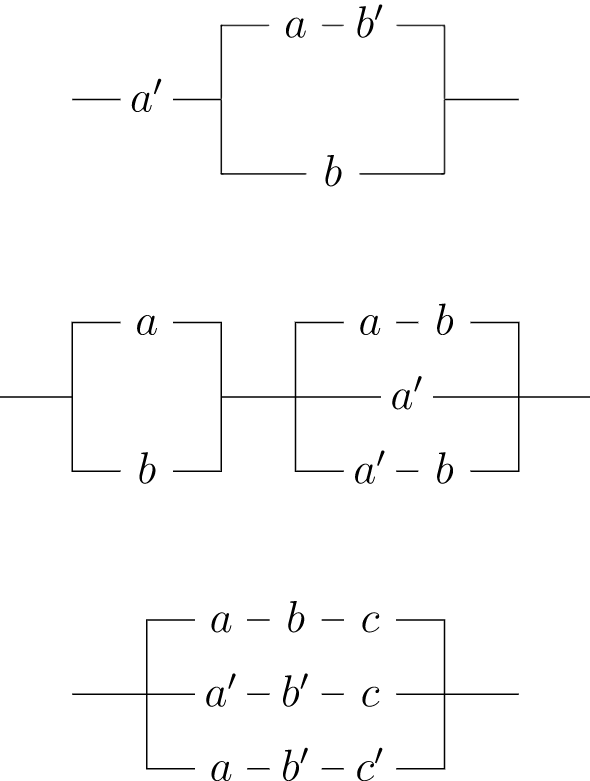19.5: Exercises
- Page ID
- 81193
Draw the lattice diagram for the power set of \(X = \{ a, b, c, d \}\) with the set inclusion relation, \(\subset\text{.}\)
Draw the diagram for the set of positive integers that are divisors of \(30\text{.}\) Is this poset a Boolean algebra?
Draw a diagram of the lattice of subgroups of \({\mathbb Z}_{12}\text{.}\)
Let \(B\) be the set of positive integers that are divisors of \(210\text{.}\) Define an order on \(B\) by \(a \preceq b\) if \(a \mid b\text{.}\) Prove that \(B\) is a Boolean algebra. Find a set \(X\) such that \(B\) is isomorphic to \({\mathcal P}(X)\text{.}\)
Prove or disprove: \({\mathbb Z}\) is a poset under the relation \(a \preceq b\) if \(a \mid b\text{.}\)
Draw the switching circuit for each of the following Boolean expressions.
- \(\displaystyle (a \vee b \vee a') \wedge a\)
- \(\displaystyle (a \vee b)' \wedge (a \vee b)\)
- \(\displaystyle a \vee (a \wedge b)\)
- \(\displaystyle (c \vee a \vee b) \wedge c' \wedge (a \vee b)'\)
Draw a circuit that will be closed exactly when only one of three switches \(a\text{,}\) \(b\text{,}\) and \(c\) are closed.
Prove or disprove that the two circuits shown are equivalent.

Let \(X\) be a finite set containing \(n\) elements. Prove that \(|{\cal P}(X)| = 2^n\text{.}\) Conclude that the order of any finite Boolean algebra must be \(2^n\) for some \(n \in {\mathbb N}\text{.}\)
For each of the following circuits, write a Boolean expression. If the circuit can be replaced by one with fewer switches, give the Boolean expression and draw a diagram for the new circuit.

Prove or disprove: The set of all nonzero integers is a lattice, where \(a \preceq b\) is defined by \(a \mid b\text{.}\)
Let \(L\) be a nonempty set with two binary operations \(\vee\) and \(\wedge\) satisfying the commutative, associative, idempotent, and absorption laws. We can define a partial order on \(L\text{,}\) as in Theorem \(19.14\), by \(a \preceq b\) if \(a \vee b = b\text{.}\) Prove that the greatest lower bound of \(a\) and \(b\) is \(a \wedge b\text{.}\)
Let \(G\) be a group and \(X\) be the set of subgroups of \(G\) ordered by set-theoretic inclusion. If \(H\) and \(K\) are subgroups of \(G\text{,}\) show that the least upper bound of \(H\) and \(K\) is the subgroup generated by \(H \cup K\text{.}\)
Let \(R\) be a ring and suppose that \(X\) is the set of ideals of \(R\text{.}\) Show that \(X\) is a poset ordered by set-theoretic inclusion, \(\subset\text{.}\) Define the meet of two ideals \(I\) and \(J\) in \(X\) by \(I \cap J\) and the join of \(I\) and \(J\) by \(I + J\text{.}\) Prove that the set of ideals of \(R\) is a lattice under these operations.
Let \(B\) be a Boolean algebra. Prove each of the following identities.
- \(a \vee I = I\) and \(a \wedge O = O\) for all \(a \in B\text{.}\)
- If \(a \vee b = I\) and \(a \wedge b = O\text{,}\) then \(b = a'\text{.}\)
- \((a')'=a\) for all \(a \in B\text{.}\)
- \(I' = O\) and \(O' = I\text{.}\)
- \((a \vee b)' = a' \wedge b'\) and \((a \wedge b)' = a' \vee b'\) (De Morgan's laws).
By drawing the appropriate diagrams, complete the proof of Theorem \(19.30\) to show that the switching functions form a Boolean algebra.
Let \(B\) be a Boolean algebra. Define binary operations \(+\) and \(\cdot\) on \(B\) by
\begin{align*} a + b & = (a \wedge b') \vee (a' \wedge b)\\ a \cdot b & = a \wedge b\text{.} \end{align*}
Prove that \(B\) is a commutative ring under these operations satisfying \(a^2 = a\) for all \(a \in B\text{.}\)
Let \(X\) be a poset such that for every \(a\) and \(b\) in \(X\text{,}\) either \(a \preceq b\) or \(b \preceq a\text{.}\) Then \(X\) is said to be a totally ordered set.
- Is \(a \mid b\) a total order on \({\mathbb N}\text{?}\)
- Prove that \({\mathbb N}\text{,}\) \({\mathbb Z}\text{,}\) \({\mathbb Q}\text{,}\) and \({\mathbb R}\) are totally ordered sets under the usual ordering \(\leq\text{.}\)
Let \(X\) and \(Y\) be posets. A map \(\phi : X \rightarrow Y\) is order-preserving if \(a \preceq b\) implies that \(\phi(a) \preceq \phi(b)\text{.}\) Let \(L\) and \(M\) be lattices. A map \(\psi: L \rightarrow M\) is a lattice homomorphism if \(\psi( a \vee b ) = \psi(a) \vee \psi(b)\) and \(\psi( a \wedge b ) = \psi(a) \wedge \psi(b)\text{.}\) Show that every lattice homomorphism is order-preserving, but that it is not the case that every order-preserving homomorphism is a lattice homomorphism.
Let \(B\) be a Boolean algebra. Prove that \(a = b\) if and only if \((a \wedge b') \vee ( a' \wedge b) = O\) for \(a, b \in B\text{.}\)
Let \(B\) be a Boolean algebra. Prove that \(a = O\) if and only if \((a \wedge b') \vee ( a' \wedge b) = b\) for all \(b \in B\text{.}\)
Let \(L\) and \(M\) be lattices. Define an order relation on \(L \times M\) by \(( a, b) \preceq (c, d)\) if \(a \preceq c\) and \(b \preceq d\text{.}\) Show that \(L \times M\) is a lattice under this partial order.


